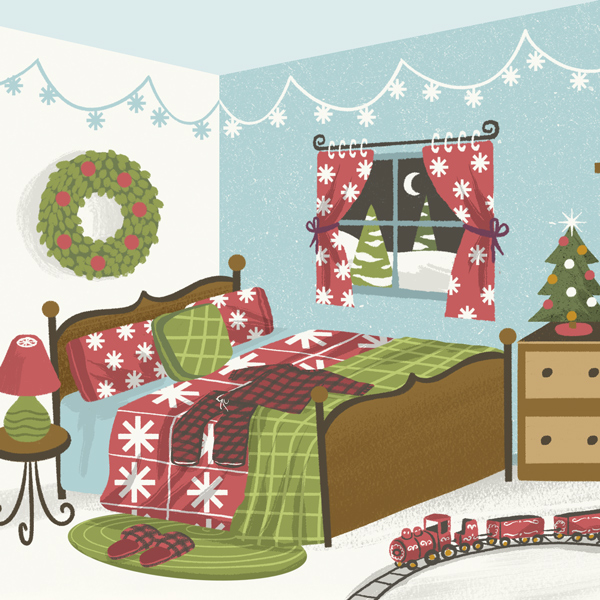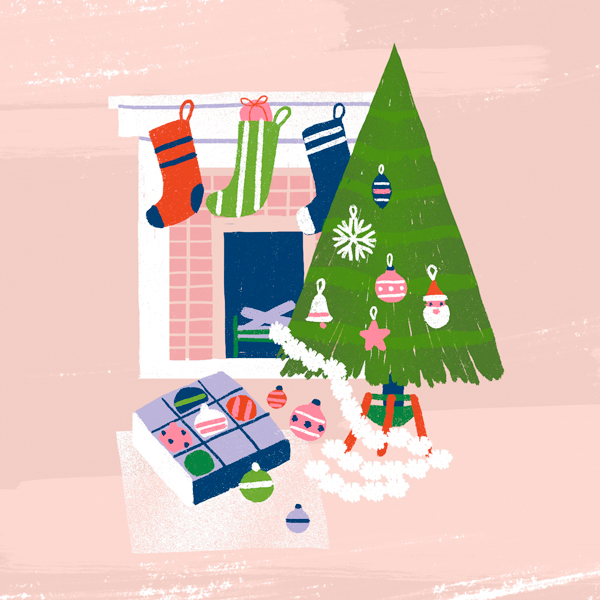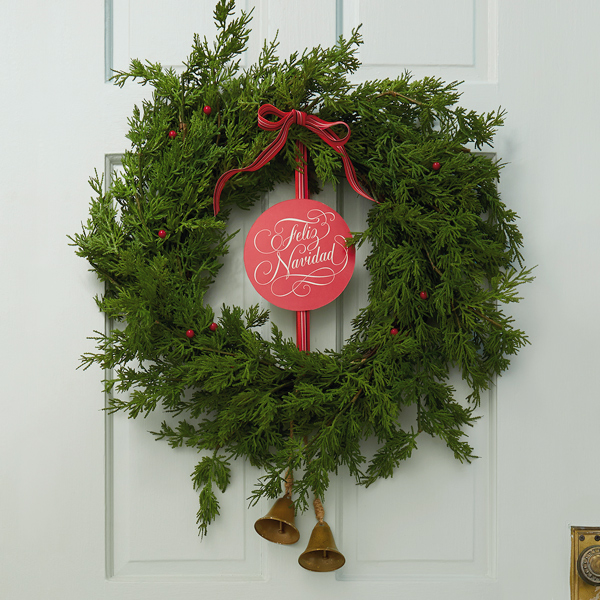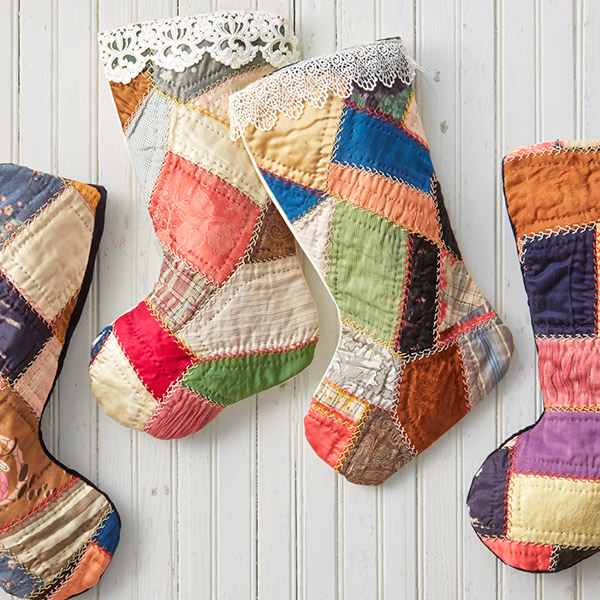How to choose a Christmas tree: Sizing and deciding between live and artificial trees

My countdown to this Christmas started last December 26th. (Don’t worry. That’s completely normal. I checked.) If you’re like me and wish you could have ALL the trees, you’re probably already twinkling with big, fat Christmas tree energy! And if you’re like regular folks, you’re probably still pretty excited about the upcoming season and looking for Christmas tree ideas—tips and tricks for how to make your tree lit.
Good tidings! This two-part series is for you. I’ve got mad Christmas tree ideas…
Inspired? Create and share by tagging @HallmarkStores.
In this first article, we’re gonna get into how to assess your space, how to choose a bomb tree within your budget, and whether to go real or to go with all the options that an artificial tree has to offer. And in the second, we’re gonna get down with some decoration ideas. Lots of them.
So if you want to tree like me, let’s do this!
1. Assess Your Space: Deciding Where to Put a Christmas Tree
Personally, I like a Rockefeller Center-size Christmas tree. But the rooms in my house believe in “reality” and insist on something considerably smaller. And guess what? It turns out that it IS easier if you buy a Christmas tree that fits your actual space. So let’s start there. And look at us! We get to be creative out of the gate. Where would you like your Christmas tree to go?
- Maybe you want to showcase your tree in a window to share its light outside and spread its warm glow with whoever passes by or is invited to your home.
- Maybe it would look more beautiful standing by an entryway or staircase.
- Maybe you’d like your tree in the middle of your room, taking center stage.
- If space is an issue, a cozy corner is always a great place for a tree.
Wherever you’d like your tree to be, the measuring tape is your friend.
Don’t be that woman who goes to the live tree lot with stars in her eyes and returns home with a Christmas tree so big that it barely fits through the door, scrapes the ceiling once it’s put in the stand, and falls literally wall-to-wall when the netting releases the boughs.
Or that woman who bought a 12-foot artificial tree only to get home, heave it out of the box and find that her ceilings were only 11 feet. (I’m that woman. Don’t be me.)
So don’t overestimate your space. Knowing my history of doing just that, I asked my friend, Hallmark Stylist and Photographer Nicole C, for some tips about Christmas tree height and fitting it in your chosen space.
- Know your ceiling height and the width of the space before you choose a tree.
- Make sure you stay 1–2 feet down from the top of your ceiling. So if you have 10-foot ceilings, consider buying a 7.5-foot tree, because you need to include the tree stand in the overall height, too.
- Don’t forget to measure your tree at the base. Pull branches at the widest point taut and measure from tip to tip. That will give you the width for when you’re considering whether the tree can fit into your corner or other space.
- Think about scale as well as size. Size is the dimensions of your tree. Scale is the size of your tree relative to other things in your room.
In other words, you don’t want the tree to have more living space than you do. It shouldn’t fill up a doorway, obstruct your foot traffic or overpower the room. You know…like what happened to that woman.
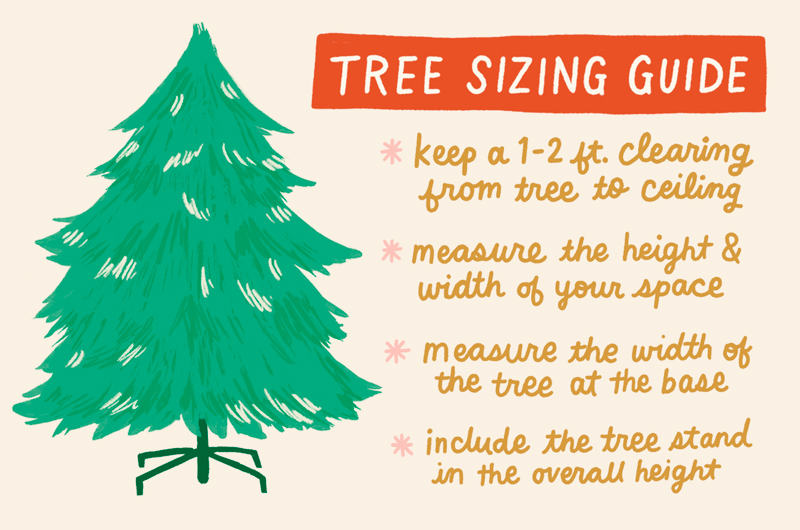
Pro tip: I did learn a helpful hack after those unfortunate size episodes—tape off the dimensions and height of your tree space using colorful packing tape to give your eye a sense of the space you will fill. Then you’ve set your expectations for what to look for in choosing your tree.
2. Picking Out a Christmas Tree: Living Live or Going Artificial?
When it comes to deciding between real or artificial Christmas trees, you’ll often hear people say there’s nothing like a live Christmas tree. And those people are right.
Ooooh, that smell! The soft feel of the needles. The body-mind health aspects of having a 6–10-foot living plant in your space. So. Good.
If you’re on the fence about a live tree for environmental reasons, know that live trees can be decorated beautifully for the season and then put back to work for the environment. For instance, if you buy a tree with a root ball, it can be replanted.
And real trees are entirely biodegradable. A lot of organizations will take trees to convert into mulch or composted soil after Christmas. And some farms, zoos and petting zoos will take your tree as an after-Christmas treat for animals like pigs, camels, elephants and goats.
What to Look for in a Live Tree
Budget
There are a lot of affordable options with live trees, like firs, pines and spruces. When you go to the live tree lot to pick out a Christmas tree, they are generally arranged by price and type to make your selection easier. If budget is your first consideration (like it is mine), it’s not hard to find a pretty tree for your penny.
Strength
When buying a Christmas tree, take your time to feel the boughs and needles to see if they will support the types of ornaments and lights you want to hang. Some trees with softer needles and slimmer boughs will only support smaller ornaments, unless you support them with thin fishing line. And some trees will dictate to you where the ornaments and lights will be placed. If you can, bring an ornament or two with you to see which tree gives you the best hang.
Fullness
So, yup, when I choose a live tree, I give it the “ornament test.” But I also have someone else hold the tree up tall so that I can get a look at all sides. If you plan to put the tree in the middle of a room, know those angles, baby! You want it to look good from all sides to whoever is looking on the ’Gram and admiring it in your home.
Pro tip: Your tree only has to be good-looking on two or three sides if you plan to put it in a corner or on a wall. Any unfortunate side can stay a secret just between you and your tree.
Health
Also, when picking out a Christmas tree, give it a good shake to see how many needles are falling. You’re looking for resilience here. If the needles are dropping like screaming teens at a Harry Styles concert, your tree won’t likely make it through the season.
Don’t be that woman whose tree died two weeks before Christmas, who then had to remove every single light and ornament as she wept bitterly and transfer them to a Struggle Tree—the only sad and pitiful tree left on the live lot by then. (Yes. I’m also that woman.)
Species
So I learned the hard way to go for trees with durability. And now, when it comes to types of Christmas trees, I’m kind of a fir woman. Here’s how come:
- I like Fraser firs because they are beautiful, soft, very dark green, and have sturdier branches that can handle heavier ornaments and are most likely to have most of their needles at the end of celebration season.
- Balsam firs are also lovely. They have a cone shape with short, dense branches, dark green needles and a sweet foresty smell.
- It’s the Douglas fir for me though. Nothing beats that sweet, earthy, pine smell. Douglas firs generally have the perfect cone shape we’ve come to associate with Christmas trees, can handle lots of ornaments and lights, and endure the season well.

Pro Stylist Tip from Nicole: Another advantage of a live tree is that you can cut branches if you feel like the tree is a little too full or if you want to feature certain ornaments or other chosen elements. Thinning it a little can actually add longevity to the tree because it doesn’t have to support so many branches.
Caring for a Live Tree
IMPORTANT NOTE: Water! Water! Water!
So remember that woman who ended up with the Struggle Tree when her original tree died two weeks before Christmas? (Again, that was me.) Nicole explained where I went wrong. A live tree has to be watered as soon as you get it home. Which I did. But that wasn’t enough.
Nicole suggests giving your tree a fresh cut once you get home or having it cut again just before you leave the lot. By the time you buy a Christmas tree, the initial cut has sealed and can’t take in the water the tree needs to thrive. Take off three to four inches of the trunk so that you can put fresh wood into fresh water. (Keep this cut in mind when deciding the height of your tree.) You can also buy liquid food to help preserve your tree.
Make Buying a Christmas Tree Your Family Thing
Finally, buying a live Christmas tree offers you an opportunity to make some of your sweetest family memories together. Gather your gang and ride to the lighted live lots around your town until you find the right tree. Grab some cocoa and other treats for the search. Let everyone vote on the tree that feels perfect for your family. Make a party of tying it to the car, driving it home, bringing it through the door and putting it up.
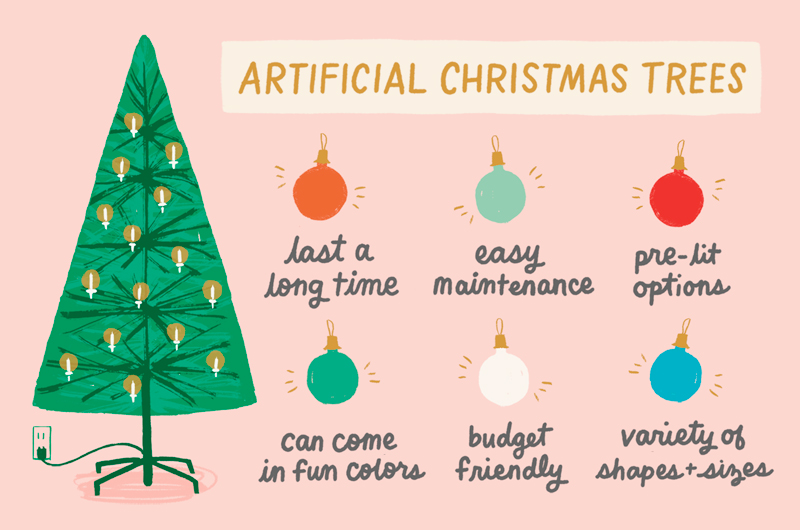
The Pros of Artificial Trees
Clearly, I think live trees are bombity.com. But I’m an equal opportunity tree-lover. Artificial trees, or “play trees” as I call them, can look just as beautiful, are easier in terms of maintenance, and last longer than live trees—several seasons in fact.
I like them because they don’t require watering and you can more easily manipulate branches and needles where you need them to go for optimal lighting and decoration treatments. Not to mention, there’s a whole lot of fun to be had in terms of style. Let me break it down…
Flexibility
Play trees accommodate every budget, from beginner to lottery winner, and come in a variety of colors, shapes and sizes.
You can buy green trees that look indistinguishable from any tree on a live lot. You can also get them in space-age colors like silver, gold or platinum, or fashion colors like hot pink, fuchsia and snow white. If your heart desires, you can find them in team colors like royal blue, yellow, orange or red.
You can even buy striped, polka-dotted and rainbow trees. Know what that means? You can make your joyful statement as subtly or as loud as you want to!
Play trees also give you a lot more options when it comes to size. I like pencil trees because they’re as tall as regular trees but take up much less floor space. They also happen to support my perspective that every room in the house can host a tree. Or two. Or four, depending on the room.
(Sidenote: If you’re worried about room, keep in mind that you will need somewhere to store an artificial tree.)
The deal on artificial Christmas tree sizes:
- Pencil trees can measure anywhere from 4–16 feet tall but take up only 18–23 inches of floor space.
- Slim trees are a little fuller at the base at 24–40 inches.
- Medium trees are between 40 and 54 inches in diameter.
- Full trees come in between 56 and 64 inches.
I use a mix of tree sizes in my home to create something special for every room, and my rooms never feel crowded. For instance, I use three pencil trees of varying heights and one full tree in my living room. It feels like a fairy-lit forest in the end.
But I am not judging people who feel like one Christmas tree per season is enough. Let your freak flags fly, one-treers! Again: Your season. Your celebration.
Pre-Lit Perfection
You can buy artificial trees with or without lights. I buy pre-lit trees for ease because lights are already attached to the tips of boughs. That means I don’t have to worry about unwinding endless strings of tangle-able lights and accidentally losing my religion in frustration. I also dig that there are fewer cords showing.
Having said that, I do love adding an extra string of lights or two for more glow and show. Another tip from Nicole: You don’t have to take off any lights you add to the tree. You can leave them on between seasons, making the setup for the next year easier.
Pro tip: If you’ve got your naked tree set up and it’s looking a little spare—especially if you’ve bought a less expensive tree—buy a couple of real or artificial garlands, depending on your tree type, to wrap around the trunk and fill in any obvious holes. Try to match your tree as closely as possible, but don’t worry if you don’t get a perfect match. A little contrast can add interest and beauty.
I do have one beef with artificial trees: I miss the smell of real trees. Nothing can replace that. But good news—You can get pretty close.
Here are a couple of hacks from me to you:
- Buy a real pine wreath to hang somewhere near your tree. The fresh aroma suffuses the room and adds a fresh outdoor Christmas feel.
- Tuck a scented pinecone deep into the back of your tree; the added scent is a bonus Christmas treat.
I discovered the pinecone thing last year when my family, apparently overcome by the blaring holly jolly of Christmas music in the craft store, brought home a ginormous bag of cinnamon-scented pinecones nobody knew what to do with.
If you’re not down with artificial scents or have a sensitivity to them, make Christmas sachets with your own favorite blends (think natural pine, orange zest, cinnamon) to tuck into your tree.
Now that you’ve got your Christmas tree in the bag, check out the next article in this series to find out more about how to light it up!
Shop Christmas
See allYou may also like
See more-
Christmas This way to the North Pole: 50+ Kids Bedroom Christmas Decoration Ideas
Kids LOVE getting to express themselves—especially when it comes to their rooms. And when it comes to Christmas-lovin...
-
Parties & Entertaining Photo-worthy holiday tablescapes: 40+ Christmas, Hanukkah and New Year’s Eve table decoration ideas
I’ve always loved interior design. This has resulted in hours of gazing at stylish tablescapes, reveling in the color...
-
Christmas 6 Creative Christmas Card Display Ideas
Holiday card season is here: Our mailboxes are about to fill up with festive envelopes with pretty stamps and familia...
-
Christmas The best Christmas ornament storage ideas to keep them safe and sparkling
At Hallmark, we get a lot of questions regarding Keepsake Ornaments. But surprisingly, a lot of them are not about wh...
-
Christmas How to Decorate a Christmas Tree: Professional Styling Tips on Lights, Ornaments and More
It’s time to make your tree show up and show out! You’ve scouted out your space, decided on the size and nature (or f...
-
Christmas Easy DIY Personalized Wreaths to Welcome Holiday Visitors
When holiday visitors come knocking, your front door is the first thing they see. Now, that’s not to say that all the...
-
Christmas Memories in the making: DIY Christmas stockings
Maybe you’re blessed, like me, with many inherited quilts, but you don’t quite know what to do with them once they...

